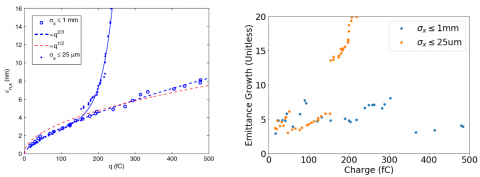New metrics to compute the beam brightness
C. M. Pierce, I.V. Bazarov, C.M. Gulliford, J.M. Maxson, S. Baturin, M.A. Gordon, Y.K. Kim
Recently, CBB has applied its previous injector optimization experience to assess the impact of exceptionally bright sources on injectors for ultrafast electron diffraction (UED), free electron lasers (FEL), and energy recovery linacs (ERL). These bright sources, now in development by CBB, use very high electric fields and photoemission with low (or zero) mean transverse energy, MTE. To assess the impact, it quantified the RMS emittance at the delivery point.
The studies show that for many bunch sizes and charges, the RMS emittance is preserved as the beam moves from source to delivery point, while for the most compact bunches and largest charge, emittance grows during delivery. But there's hope even for these beams. CBB studies show that the emittance of their core is preserved, and new figures of merit that capture this feature are now used to guide the design of improved photoinjectors providing higher brightness beams.
Link to Full Publication:
http://accelconf.web.cern.ch/AccelConf/ipac2018/doi/JACoW-IPAC2018-THPAF024.html

